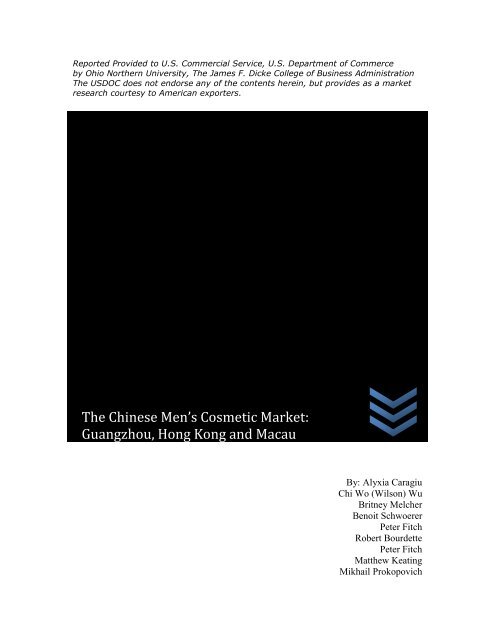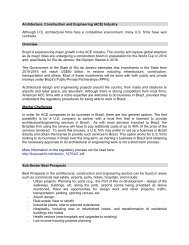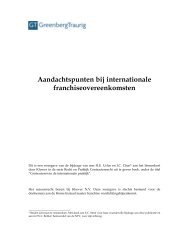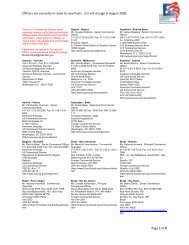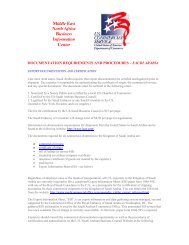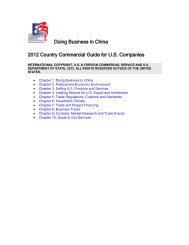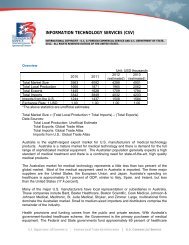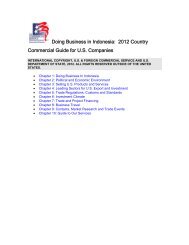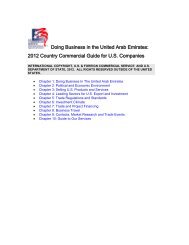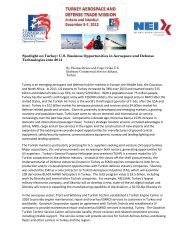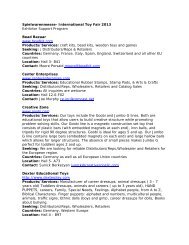The Chinese Men's Cosmetic Market: Guangzhou, Hong Kong and ...
The Chinese Men's Cosmetic Market: Guangzhou, Hong Kong and ...
The Chinese Men's Cosmetic Market: Guangzhou, Hong Kong and ...
You also want an ePaper? Increase the reach of your titles
YUMPU automatically turns print PDFs into web optimized ePapers that Google loves.
Reported Provided to U.S. Commercial Service, U.S. Department of Commerce<br />
by Ohio Northern University, <strong>The</strong> James F. Dicke College of Business Administration<br />
<strong>The</strong> USDOC does not endorse any of the contents herein, but provides as a market<br />
research courtesy to American exporters.<br />
<strong>The</strong> <strong>Chinese</strong> Men’s <strong>Cosmetic</strong> <strong>Market</strong>:<br />
<strong>Guangzhou</strong>, <strong>Hong</strong> <strong>Kong</strong> <strong>and</strong> Macau<br />
By: Alyxia Caragiu<br />
Chi Wo (Wilson) Wu<br />
Britney Melcher<br />
Benoit Schwoerer<br />
Peter Fitch<br />
Robert Bourdette<br />
Peter Fitch<br />
Matthew Keating<br />
Mikhail Prokopovich
2<br />
Contents<br />
Contents .............................................................................................................................. 2<br />
Abstract ............................................................................................................................... 3<br />
Men’s <strong>Cosmetic</strong>s Products .................................................................................................. 3<br />
Overview of the <strong>Cosmetic</strong> <strong>Market</strong> ...................................................................................... 4<br />
Overview of the prospective cities of <strong>Hong</strong> <strong>Kong</strong>, Macau, <strong>and</strong> <strong>Guangzhou</strong> ..................... 5<br />
<strong>Market</strong> Dynamics ................................................................................................................ 6<br />
<strong>Market</strong> Dem<strong>and</strong> .................................................................................................................. 8<br />
Consumer Behavior: ........................................................................................................... 9<br />
Purchasing decision influence factors ............................................................................... 10<br />
Primary Research .............................................................................................................. 11<br />
<strong>Market</strong> Entry Strategies .................................................................................................... 12<br />
<strong>Chinese</strong> Politics ................................................................................................................. 15<br />
Advertising Regulations.................................................................................................... 18<br />
Conclusion ........................................................................................................................ 20<br />
Works Cited ...................................................................................................................... 21
Abstract<br />
This paper focuses on exploring what is sure to be a market with high growth<br />
potential: the men’s cosmetics market in China. <strong>The</strong> market opportunities within the<br />
areas of, <strong>Hong</strong> <strong>Kong</strong>, <strong>Guangzhou</strong>, <strong>and</strong> Macau will be identified <strong>and</strong> discussed throughout<br />
this paper. Research has been conducted on the size, characteristics, dem<strong>and</strong>, consumer<br />
attributes, <strong>and</strong> potential market entry strategies. Primary research was conducted on a<br />
sample of consumers within these markets, the results of which are detailed below.<br />
Additionally, the legal requirements <strong>and</strong> political characteristics of each individual region<br />
have been identified <strong>and</strong> links have been provided to ease the research process. <strong>The</strong> goal<br />
of this paper is to aid American firms in underst<strong>and</strong>ing the male cosmetic market in<br />
China <strong>and</strong> to provide valuable information that will help these firms identify profitable<br />
segments within various regions. To those who grasp this unique culture <strong>and</strong> business<br />
l<strong>and</strong>scape there are great rewards to be gained from involvement in the industry of male<br />
cosmetics.<br />
Men’s <strong>Cosmetic</strong>s Products<br />
<strong>The</strong>re are numerous types of men’s cosmetics products. In fact, there are almost<br />
as many cosmetic products directed towards the male consumer as there are for the<br />
female consumers. Some of the most common products used by the <strong>Chinese</strong> male<br />
consumer include facial cleansers, body <strong>and</strong> hair care, shaving care, moisturizers,<br />
fragrance, lip moisturizer, <strong>and</strong> deodorants. Within the areas of <strong>Hong</strong> <strong>Kong</strong> <strong>and</strong> Macau,<br />
the product offerings have become more extensive <strong>and</strong> sophisticated. Product lines<br />
include “anti-ageing, exfoliating <strong>and</strong> energy-boosting properties… Several cosmetics<br />
firms led by L'Oreal have introduced China-specific products, such as face whitening<br />
creams” (Jones). L’Oreal is also selling its newly developed charcoal mousse for men in<br />
China, something that is expected to become a bestseller (Jones). According to a<br />
spokesman for Procter & Gamble, “Spending by <strong>Chinese</strong> men on all kinds of face<br />
creams, anti-aging gels <strong>and</strong> cleansing lotions already exceeds spending on razors <strong>and</strong><br />
blades by a factor of 4:3 <strong>and</strong> the gap will keep widening” (Balfour). Some of the best<br />
selling men’s products include: “L’Oreal’s Men Expert line, which is the No. 1 br<strong>and</strong><br />
within China <strong>and</strong> has helped L’Oreal gain a 32 percent market share in 2009. Other key<br />
products include the domestic br<strong>and</strong> GF’s creams <strong>and</strong> lotions, followed by premium<br />
skincare products developed by Shiseido, Dior, <strong>and</strong> Clinique.” (Red Luxury) According<br />
to ChinaPolling, “Almost 99% of male consumers regularly use cosmetics, with facial<br />
cleanser, body <strong>and</strong> hair care, <strong>and</strong> shaving cream being the most frequently used products”<br />
(CinaPolling). <strong>Chinese</strong> men are beginning to feel the pressure of fast-paced life style <strong>and</strong><br />
are turning to male cosmetics to boost their appearance <strong>and</strong> give them a competitive edge<br />
within their personal <strong>and</strong> professional lives. Though some men are not quite ready to be<br />
“Du Shi Yu Nan” or City Jade Men, the name given to men who purchase <strong>and</strong> use<br />
3
cosmetics (<strong>and</strong> the local language term that translates to “metrosexuals”), studies show<br />
that 50% of purchases at L’Oreal’s China stores come from women buying for their<br />
husb<strong>and</strong>s <strong>and</strong> boyfriends (Balfour).<br />
Overview of the <strong>Cosmetic</strong> <strong>Market</strong><br />
4<br />
<strong>Hong</strong> <strong>Kong</strong> & Macau<br />
<strong>The</strong> manufacturing sector for cosmetics <strong>and</strong> toiletries in <strong>Hong</strong> <strong>Kong</strong> is fairly<br />
small. Most local manufacturers produce toiletries <strong>and</strong> perfumes that compete at a low<br />
price level. In the mid to high end market, international br<strong>and</strong>s overtake local ones.<br />
Lately, international companies such as Sulwhasoo, Kiehl’s <strong>and</strong> L’Occitane are making<br />
men’s skin care products in addition to their female product lines. (HKTDC)<br />
As of December 2010, there were 80 establishments in <strong>Hong</strong> <strong>Kong</strong> producing<br />
cosmetics. Most of the companies in the industry are traders who sell to the <strong>Chinese</strong><br />
mainl<strong>and</strong>, United States, Macau, Japan, Southeast Asia <strong>and</strong> the European markets.<br />
(HKTDC) <strong>The</strong> <strong>Chinese</strong> Mainl<strong>and</strong> accounts for 19.7% of <strong>Hong</strong> <strong>Kong</strong>’s cosmetic product<br />
exports, followed closely by Macau, with 19.5%. <strong>The</strong> United States st<strong>and</strong>s at number<br />
three, with 13% of exports from <strong>Hong</strong> <strong>Kong</strong>. (HKTDC)<br />
Some mid to high-end foreign br<strong>and</strong>s procure sales counters in department stores<br />
<strong>and</strong> often set up outlets within shopping centers. Salons often sell professional grade<br />
products <strong>and</strong> specialty cosmetics chains sell international br<strong>and</strong>s at heavily discounted<br />
prices. International br<strong>and</strong>s have strengthened their sales by selling their products through<br />
various internet sites. (HKTDC)<br />
Research shows that <strong>Hong</strong> <strong>Kong</strong> consumers are using popular br<strong>and</strong>s <strong>and</strong><br />
products made from natural ingredients. (New Zeal<strong>and</strong> Trade <strong>and</strong> Enterprise) Large<br />
product categories in this segment include facial moisturizers, anti-aging products, makeup<br />
foundation, lipsticks <strong>and</strong> eye makeup. (New Zeal<strong>and</strong> Trade <strong>and</strong> Enterprise)<br />
In <strong>Hong</strong> <strong>Kong</strong>, the skincare market grew 9% from 2002 to 2007. In 2007, 85% of<br />
the market share was comprised of skincare products. Another 12% market share was<br />
evenly divided between body products <strong>and</strong> sun care. (New Zeal<strong>and</strong> Trade <strong>and</strong> Enterprise)<br />
Increasing amounts of tourists from mainl<strong>and</strong> China have boosted cosmetic<br />
industry sales. “According to the <strong>Hong</strong> <strong>Kong</strong> Tourism Board, about 80% of the mainl<strong>and</strong><br />
<strong>Chinese</strong> tourists who visited <strong>Hong</strong> <strong>Kong</strong> ‘went shopping’ <strong>and</strong> cosmetic <strong>and</strong> skincare<br />
products were among their top 3 shopping purchases”. (New Zeal<strong>and</strong> Trade <strong>and</strong><br />
Enterprise)<br />
As the average age in China increases, there continues to be a strong dem<strong>and</strong> for<br />
anti-aging “cosmeceutical” products that feature a concoction of vitamins, herbs, <strong>and</strong><br />
sometimes pharmaceuticals such as vitamin C lotions, tea tree oil-infused cleansers <strong>and</strong><br />
collagen masks.<br />
In <strong>Hong</strong> <strong>Kong</strong>, men currently make up less than 10% of the total expenditure on<br />
skincare products. However, many well established br<strong>and</strong>s such as L’Oreal <strong>and</strong> Shiseido
are taking advantage of this emerging market by creating product lines especially for men<br />
<strong>and</strong> opening up men-only skincare centers. (New Zeal<strong>and</strong> Trade <strong>and</strong> Enterprise)<br />
Very little industry data can be found for Macau. A case can be argued that<br />
Macau, however, is very similar to <strong>Hong</strong> <strong>Kong</strong> in terms of the men’s cosmetic market.<br />
Both regions are special administrative regions in China <strong>and</strong> enjoy more freedom when it<br />
comes to foreign trade. Both cities have had a history heavily influenced by European<br />
foreigners <strong>and</strong> share many of the same consumer tastes <strong>and</strong> preferences.<br />
5<br />
<strong>Guangzhou</strong> & Mainl<strong>and</strong> China<br />
In mainl<strong>and</strong> China, domestic products are more popular in the lower-end<br />
segments, while international br<strong>and</strong>s are the main players within the mid- to high-end<br />
market. (Li & Fung Research Center) <strong>The</strong> sales value of cosmetics has increased steadily<br />
from 2005 to 2009 in mainl<strong>and</strong> China, hitting $111 billion in 2009. (Li & Fung Research<br />
Center) <strong>The</strong>se numbers look very promising; however increase in costs, such as “rental,<br />
labor, logistics, advertisement, <strong>and</strong> slotting fee etc. are exerting heavy pressure on<br />
cosmetic enterprises.” (Li & Fung Research Center) “Many cosmetics players, especially<br />
those with poorer br<strong>and</strong> equity, have witnessed their profit margin eroding.” (Li & Fung<br />
Research Center)<br />
Unexpectedly, <strong>Guangzhou</strong> is the center for cosmetics <strong>and</strong> beauty product<br />
transactions in China. <strong>The</strong> annual beauty cosmetics transactions in <strong>Guangzhou</strong> accounted<br />
for over 40% of the country’s transactions in this industry. (Wholesale<strong>Market</strong>) <strong>The</strong><br />
Guangdong province (of which <strong>Guangzhou</strong> is the capital) has been center of the local<br />
beauty <strong>and</strong> fashion industry since the 1980’s. It serves as the entry point for many<br />
international companies seeking to take part in the <strong>Chinese</strong> market. “Of the 2,800<br />
producers of beauty, hair, cosmetic, personal daily care <strong>and</strong> toiletry products in China,<br />
1,500 are found in the Guangdong province, across cities such as <strong>Guangzhou</strong>, Shantou,<br />
<strong>and</strong> others. <strong>The</strong>se cities alone are collectively responsible for 70% of the output in<br />
China.” (ForeignerCN.com) Guangdong is known as having the most mature supply<br />
chain industry <strong>and</strong> the most advanced infrastructure system compared to other provinces.<br />
Additionally, these regions are considered to be the most appropriate environment for the<br />
beauty <strong>and</strong> cosmetic industry. (ForeignerCN.com)<br />
<strong>The</strong> men’s skin care <strong>and</strong> cosmetics market within <strong>Guangzhou</strong> reached a record of<br />
$1.1 million in 2008 <strong>and</strong> was predicted to hit $2.1 million in 2010. <strong>The</strong> market<br />
penetration for the men’s cosmetic market is low <strong>and</strong> thus rapid sales growth is apparent.<br />
“<strong>Market</strong> specialists point out that young men, aged between 18 <strong>and</strong> 25, including students<br />
<strong>and</strong> white-collar workers are still the major customers <strong>and</strong> main drivers of growth in the<br />
market”. (UK Trade <strong>and</strong> Investment)<br />
Overview of the prospective cities of <strong>Hong</strong> <strong>Kong</strong>, Macau, <strong>and</strong> <strong>Guangzhou</strong><br />
Shanghai <strong>and</strong> Beijing are the most well-known <strong>and</strong> prosperous cities within<br />
China. <strong>The</strong> cosmetic markets in those two cities are competitive <strong>and</strong> condensed, which<br />
makes almost impossible for some small companies to enter the cosmetic market. In<br />
addition, those global companies are looking for any means to increase their market
shares. <strong>The</strong>refore, it is essential to be able to identify any secondary cities that would<br />
become the next Shanghai or Beijing, which has over 6 million <strong>and</strong> 8 million visitors per<br />
year respectively (Facts <strong>and</strong> Details). <strong>The</strong>re are a few secondary cities that show a huge<br />
potential growth in cosmetic market <strong>and</strong> long term profit. Those secondary cities are<br />
<strong>Guangzhou</strong>, Macau, <strong>and</strong> <strong>Hong</strong> <strong>Kong</strong>. <strong>Guangzhou</strong> is the key national transportation hub<br />
<strong>and</strong> trading port <strong>and</strong> it is the third largest city in China as well as the largest city in<br />
southern China. Economically, <strong>Guangzhou</strong> is one of mainl<strong>and</strong> China’s leading<br />
commercial <strong>and</strong> manufacturing regions. In 2009, the GDP reached $133.5 billion, with<br />
total income per capita around $13,111. Additionally, <strong>Guangzhou</strong> has the International<br />
Beauty Expo annually, which is the most influential beauty trade event in China. <strong>The</strong><br />
expo attracts visitors from all over China, Asia, Europe, America, <strong>and</strong> the Pacific region.<br />
With 10 exhibition halls presenting a wide spectrum of beauty <strong>and</strong> related products, each<br />
edition recorded over 200,000 entries by trade buyers <strong>and</strong> professional visitors in 2010<br />
(CantonFair.net). <strong>The</strong> <strong>Guangzhou</strong> Beauty Expo has become one of the best known beauty<br />
industry events in the world. <strong>The</strong> men’s cosmetic market within Macau <strong>and</strong> <strong>Hong</strong> <strong>Kong</strong><br />
are expected to see significant growth for several reasons. First, the mainl<strong>and</strong> granted all<br />
<strong>Hong</strong> <strong>Kong</strong> <strong>and</strong> Macau products tariff-free treatment under the Mainl<strong>and</strong> <strong>and</strong> <strong>Hong</strong> <strong>Kong</strong><br />
Closer Economic Partnership Arrangement (CEPA). All goods made in <strong>Hong</strong> <strong>Kong</strong>,<br />
including cosmetics <strong>and</strong> toiletries products subject to the CEPA’s rule of origin, can<br />
enjoy duty-free access to the <strong>Chinese</strong> mainl<strong>and</strong> since January 2006. Second, there are 28<br />
million visitors <strong>and</strong> 14.6 million visitors to Macau <strong>and</strong> <strong>Hong</strong> <strong>Kong</strong> each year<br />
respectively. An estimated 58 percent of these visitors from mainl<strong>and</strong> China come to<br />
Macau each, <strong>and</strong> the number of visitors has increased at a steady rate 13.4 percent since<br />
2007 (HKTDC).<br />
With the arrival of mainl<strong>and</strong> tourists under the individual visitor scheme <strong>and</strong> the<br />
concomitant surge in <strong>Hong</strong> <strong>Kong</strong>’s cosmetics sales, many businessmen are eyeing the<br />
lucrative local cosmetics market. <strong>Hong</strong> <strong>Kong</strong> is often viewed as a showcase region for<br />
foreign br<strong>and</strong>s wishing to target mainl<strong>and</strong> customers <strong>and</strong> has continued to attract new<br />
br<strong>and</strong>s. Thirdly, <strong>Chinese</strong> men are becoming much more health <strong>and</strong> appearance cautious<br />
within the secondary cities. In addition, the dem<strong>and</strong> for men’s cosmetic products has<br />
been increasing consistently since appearance takes a more important in business in<br />
China. This change has often been referred to as the “beauty economy”. Finally, the<br />
purchasing power for the middle class <strong>and</strong> the willingness to spend money on cosmetics<br />
products are ranked among the top five compared to the rest of secondary cities in China,<br />
which explains why <strong>Guangzhou</strong>, Macau, <strong>and</strong> <strong>Hong</strong> <strong>Kong</strong> are the three of the most<br />
attractive secondary cities to many cosmetic companies.<br />
<strong>Market</strong> Dynamics<br />
China currently st<strong>and</strong>s as the second-largest economy in the world with $10.09<br />
trillion in sales in 2010 (CIA). With a GDP growth rate of 9% per year <strong>and</strong> a steady<br />
increase in disposable income, there is a large market for companies interested in<br />
pursuing the market for personal care items (Nielson). Fueling China’s economic boom is<br />
the increased migration to urban areas over the past 10 years. Increased work<br />
opportunities in urban areas have lead to a steady increase in disposable income at a level<br />
6
3 times that of rural China (Nielson). By 2025, it is projected that 59% of China’s urban<br />
households will be in the upper middle class <strong>and</strong> earning between $20,000 <strong>and</strong> $40,000<br />
per year (Nielson). This increase will stimulate spending in areas such as food, apparel,<br />
household products, <strong>and</strong> personal products.<br />
Growing Middle Class<br />
According to <strong>The</strong> China State Information Center (CSIC), the <strong>Chinese</strong> middle<br />
class currently contains around 300 million people. While classifications differ, if a<br />
<strong>Chinese</strong> citizen has a stable income sufficient to afford an apartment, a car, a child’s<br />
education, <strong>and</strong> more discretionary purchases, they are likely to be considered members of<br />
the middle class (LiAnne Yu). As of 2010, about 25% of the population falls into this<br />
category (Nielson). <strong>The</strong>re has been a 350% increase in per capita income over the last 60<br />
years <strong>and</strong> the population is on track to create a 700% growth over the next 20 years. By<br />
2025, there should be a consumer market of around 1.3 billion people (Nielson).<br />
Although the wealth is highly concentrated in urban areas, overall increased income is<br />
driving the spending habits of the population (Nielson).<br />
7<br />
China’s New Consumer<br />
China’s new consumers view products as status symbols (LiAnne Yu). Increased<br />
competition in the job market has caused a recent surge in the cosmetic industry as<br />
individuals are looking to differentiate <strong>and</strong> improve their appearance to improve their<br />
professional st<strong>and</strong>ing. <strong>The</strong> wealthiest consumers in China will be between 25 <strong>and</strong> 44<br />
years of age (Nielson). China’s new consumers are young, have higher incomes, <strong>and</strong><br />
access to more information. <strong>The</strong>se shoppers frequent hypermarkets <strong>and</strong> supermarkets<br />
channels for their spending channels. “Convenient to get”, “Staff provided good service,”<br />
<strong>and</strong> “clean <strong>and</strong> hygienic stores” are the key drivers influencing where these customers<br />
choose to shop (Nielson).<br />
<strong>Chinese</strong> Consumer Confidence<br />
<strong>The</strong> Consumer Confidence Index measures the degree of optimism that<br />
consumers feel about the overall state of the economy <strong>and</strong> their personal finances.<br />
Consumer confidence levels above <strong>and</strong> below a base of 100 represent varying degrees of<br />
optimism <strong>and</strong> pessimism. Shoppers growing confidence reflects an increased willingness<br />
<strong>and</strong> ability to spend (Daily). <strong>The</strong> Nielson Consumer Confidence survey asks over 3,500<br />
<strong>Chinese</strong> how confidently they feel in regards to their job, financial prospects, <strong>and</strong><br />
willingness to spend (Nielson). Results from the most recent survey indicate that <strong>Chinese</strong><br />
consumers are increasingly optimistic. In the most recent Nielson survey from 2009,<br />
China’s average consumer confidence score was 103 while the world average was only<br />
87 (Economics).<br />
<strong>Cosmetic</strong> <strong>Market</strong><br />
On a national level, shampoo leads the non-food spending categories with an annual<br />
growth rate of around 7%. Additionally, skin moisturizer has an annual growth rate of<br />
around 11%. Toner achieved the highest non-food growth rate with a 37% national sales
value growth from 2008-2009 (Nielson). <strong>The</strong> significant amount of growth has come<br />
from the recent emergence of men’s cosmetic products. <strong>Hong</strong> <strong>Kong</strong> is one of the most<br />
significant areas of opportunity for men’s skin care products. <strong>The</strong> Deloitte Business case<br />
study states that <strong>Hong</strong> <strong>Kong</strong> is an important launch pad for marketing cosmetics <strong>and</strong><br />
skincare products into the mainl<strong>and</strong> <strong>Chinese</strong> market (Deloitte). Over 23 million tourists<br />
visit <strong>Hong</strong> <strong>Kong</strong> for shopping <strong>and</strong> tourism each year with a majority of those visitors<br />
from the mainl<strong>and</strong>. Retailers <strong>and</strong> distributors are eager to increase the variety of men’s<br />
cosmetic products <strong>and</strong> are looking to cater to needs of the local population (Deloitte). In<br />
2010, the size of the cosmetic market was estimated at $1.169 billion <strong>and</strong> is expected to<br />
grow 21% in 2012. Male consumers in <strong>Hong</strong> <strong>Kong</strong> between 30 <strong>and</strong> 49 represent the<br />
largest age group, have the highest disposable income, <strong>and</strong> are the biggest buyers of<br />
men’s skincare products (Deloitte). To help meet the dem<strong>and</strong>s of the market, there has<br />
been an increase in the number of men-only skincare salons opening throughout this<br />
region (Deloitte).<br />
<strong>Market</strong> Dem<strong>and</strong><br />
8<br />
Size of <strong>Market</strong> <strong>and</strong> Potential <strong>Market</strong> Growth<br />
As the job markets are becoming more saturated <strong>and</strong> competitive, men are<br />
beginning to show more of an interest in how they look. This phenomenon has created a<br />
large market for men’s cosmetic products. <strong>The</strong> male cosmetic industry in China is seeing<br />
aggressive growth rates in several regions. With about ten percent of <strong>Chinese</strong> men<br />
already using skin care products made specifically for them the market is projected to<br />
exp<strong>and</strong> by 28.7 percent by 2014 (Terradaily.com). Research indicates that as a man’s<br />
income rises in China they will begin to purchase personal care cosmetics in order for<br />
them to get ahead professionally. <strong>The</strong> current leading consumers of men’s cosmetics in<br />
China are the white-collar workers who are entrepreneurs with above average salaries.<br />
China will account for half of global growth in the men’s skin care market from 2009-<br />
2014 which opens up huge opportunity for growth for cosmetic companies<br />
(Euromonitor). Even though 500 of the 3500 cosmetic manufactures in China are foreign<br />
owned they control eighty percent of the market share (Facts<strong>and</strong>details.com/China). In<br />
2010 the sale of men’s skin care products increased by thirty percent to $280 million in<br />
China, ahead of the United States (Terradaily.com). Increasing consumer-lending<br />
dem<strong>and</strong> for specialized products will drive the <strong>Chinese</strong> cosmetics <strong>and</strong> toiletries market to<br />
grow at a compound annual growth rate of around 12% during 2011-2014, says<br />
RNCOS.com. With such a spike in dem<strong>and</strong> for male cosmetics, spa’s are unable to keep<br />
up with dem<strong>and</strong> which results in opportunity for retail sales for companies like Proctor<br />
<strong>and</strong> Gamble <strong>and</strong> L’Oreal.<br />
Research demonstrates that men are embarrassed to buy cosmetics for themselves<br />
<strong>and</strong> often have a family member or wife purchase the products for them which results in<br />
female <strong>and</strong> male cosmetics to be sold together in China for ease of sale. In 2010, the<br />
population in China was 1,339,724,852 with 51.27% being males. With about 72% of the
675 million males in China falling between the ages of 15-65 this leaves a potential<br />
market of about 410 million males with only 41 million or ten percent currently<br />
purchasing cosmetics leaves about 369 million potential new customers. This is a<br />
massive market size to target which opens opportunity to current <strong>and</strong> new cosmetic<br />
manufacturers <strong>and</strong> retailers.<br />
Consumer Behavior:<br />
<strong>The</strong> Gross domestic product (GDP) at purchasing power parity (PPP) is the<br />
sum value of all goods <strong>and</strong> services produced in a given year at prices prevailing in the<br />
United States. Here are the figures for the year 2010.<br />
<strong>Hong</strong> <strong>Kong</strong> Macau Shenzhen <strong>Guangzhou</strong><br />
GDP PPP<br />
(billion $)<br />
224.46 31.27 146.44 163.32<br />
GDP per capita ($) 34,587 59,451 14,615 12,860<br />
<strong>The</strong> GDP per capita is the gross domestic product divided by the population. We can see<br />
that Macau <strong>and</strong> <strong>Hong</strong> <strong>Kong</strong> have a high purchasing power. (GDP; PPP (US dollar) )<br />
It means that many people likely have the disposable income to afford non-essential<br />
lifestyle products such as cosmetics. <strong>The</strong>refore, these markets are very interesting.<br />
9<br />
<strong>Chinese</strong> general tastes <strong>and</strong> preferences:<br />
<strong>Chinese</strong> consumers who are concerned about the environment mainly live in<br />
the big cities like Shanghai or Beijing. More <strong>and</strong> more of these men are also concerned<br />
with their health status. This is why many advertising campaigns use issues such as being<br />
overweight, pollution, <strong>and</strong> skin care issues to create a dem<strong>and</strong> for their products. <strong>Chinese</strong><br />
consumers are unpredictable <strong>and</strong> dem<strong>and</strong>ing <strong>and</strong> many factors may come into play when<br />
buying a product. <strong>The</strong>re are not as br<strong>and</strong> loyal as American consumers but they love<br />
famous br<strong>and</strong>s. (Labbr<strong>and</strong>) <strong>The</strong>y are very influenced by price <strong>and</strong> innovations. <strong>Chinese</strong><br />
people also appreciate luxury goods <strong>and</strong> products associated with luxury. A good<br />
cosmetic product must highlight the health benefits <strong>and</strong> have a relatively luxurious<br />
packaging with a price comparable to those of the competitors. Those purchasing<br />
decision influence factors are summarized in the following graph.
Purchasing decision influence factors<br />
We can notice that the three most important purchasing factors are the features<br />
<strong>and</strong> benefits of the product, the br<strong>and</strong> name <strong>and</strong> the ingredients of the product.<br />
10<br />
29.71% 28.28%<br />
42.75%<br />
57.97%<br />
53.62%<br />
64.49%<br />
71.01%<br />
81.88%<br />
56.52%<br />
55.8% 60.14%<br />
50.72%<br />
50.72% 21.74% 19.57% 16.57%<br />
4.35% 4.35% 7.25% 7.97% 9.42% 13.77% 19.57% 21.01% 22.46% 20.29% 26.81%<br />
36.96%<br />
34.06%<br />
28.26%<br />
24.64%<br />
13.77%<br />
<strong>Cosmetic</strong> Usage Habits:<br />
43.48%<br />
Ten percent of <strong>Chinese</strong> men are already using skin care products specifically<br />
made for them (L'Oreal). <strong>The</strong>se customers typically live in urban areas. <strong>The</strong>y are more<br />
educated <strong>and</strong> more knowledgeable than the average consumer about the benefits of those<br />
products. <strong>The</strong>se consumers are mainly white-collar workers, entrepreneurs or people<br />
whose salaries are above the average (20minutes). <strong>The</strong>y are looking for safe <strong>and</strong> quality<br />
products. <strong>Chinese</strong> men believe that using skin care products can give them a competitive<br />
edge for their jobs <strong>and</strong> can help them improve their social status. (Balfour) (China's male<br />
cosmetic market of Heuristics)<br />
<strong>The</strong> attitudes have changed about men who take care of their appearance.<br />
<strong>Chinese</strong> men don’t have any problem using these products (Tianyu).This new confidence<br />
comes from the desire to impress <strong>and</strong> to show their success. Nevertheless, they are often<br />
too embarrassed to buy the products themselves. Women account for about half of the<br />
male products purchases. (Li-chyun) In fact male products sell best when they’re sold<br />
with women’s cosmetics. In this way, men no longer have to borrow cosmetics products<br />
from their wives or girlfriends.<br />
Strong<br />
Not so strong<br />
No influence
11<br />
Products used:<br />
65 percent of <strong>Chinese</strong> men who use cosmetics are using skin-cleaning products,<br />
with milks <strong>and</strong> scrubs among the most popular among shoppers.<br />
However, while sales of moisturizers <strong>and</strong> lotions may be on the rise, few men are buying<br />
facial masks. <strong>The</strong>y also are purchasing skin lotions, whitening agents, face cleansing<br />
cream, deodorant spray, mud masks <strong>and</strong> anti-aging beauty creams made especially for<br />
them. (Hays)<br />
However, the habits <strong>and</strong> products used are changing rapidly. <strong>The</strong> male cosmetics<br />
are a new market <strong>and</strong> the tastes are constantly changing. Innovation is the key to success<br />
in this market. <strong>Chinese</strong> men are ready to use more <strong>and</strong> more new products.<br />
Primary Research<br />
Primary research was conducted in order to supplement the data presented in this<br />
research. A survey was sent to 28 young people with an average age of 21 years old, the<br />
optimal age demographic for predicting future market behavior in the cosmetic industry.<br />
20 of these young people were men <strong>and</strong> 8 women. <strong>The</strong> sample was drawn from youth<br />
with permanent residence in or originally from <strong>Guangzhou</strong>, <strong>Hong</strong> <strong>Kong</strong>, Macau, our<br />
target cities. We have summarized the results below.<br />
Within the survey population, in terms of products, the most common product<br />
men chose were moisturizing cream, shaving foam, hair style produts, deodorant, <strong>and</strong><br />
cologne. <strong>The</strong> majority of men indicated that they normally buy men’s cosmetics by<br />
themselves, <strong>and</strong> they rarely buy it through their friends or family, or are given cosmetics<br />
as gifts. <strong>The</strong> average pocket money per month (in dollar) that our <strong>Chinese</strong> respondents<br />
have is about $560 dollars, <strong>and</strong> the average amount of money they would spend on<br />
cosmetic products per month is about $65 dollars, which is roughly 12 percent of their<br />
disposable income.<br />
<strong>The</strong> survey results show that men are more concerned about their appearances<br />
than ever before, <strong>and</strong> they believe cosmetic products will make them look younger.<br />
Especially in the business world, appearance is important in achieving success, <strong>and</strong> most<br />
of the students pointed out that they would be somewhat embarrassed if they were around<br />
people <strong>and</strong> did not look their best. Essentially, students use cosmetic products not only to<br />
boost up their confidence, but also for medical treatment purposes. In the men’s survey,<br />
13 out of 20 students indicated cosmetic products were necessary in every aspect of life,<br />
<strong>and</strong> past experiences have significant impact on their decision of what br<strong>and</strong>s they should<br />
purchase.<br />
Most of them would rather purchase cosmetic products through stores because it<br />
normally takes 2-3 days for delivery in China. Also, people want to try the products<br />
before purchasing them in order to avoid risk of purchasing poor quality products.<br />
Interestingly, we discovered that the men who are married or in a relationship tend to<br />
spend more money on cosmetic products than those who are single. From the women’s<br />
survey, responses showed that women expect men to use cosmetic products.<br />
Additionally, these women have indicated that it is normal for them to see men purchase<br />
cosmetic products at the store.
Surprisingly, the 8 female students who did the survey expressed that they do not<br />
believe men who wear cosmetic products are un-masculine, which is different from the<br />
past perspective of women. Another interesting aspect of the primary research indicated<br />
that women who are married or in a relationship state that their partners would make<br />
them proud if they put in the effort to look their best around their peers.<br />
<strong>Market</strong> Entry Strategies<br />
12<br />
China<br />
<strong>The</strong>re are several factors that need to be considered when entering China’s<br />
market. First is an assessment of the dem<strong>and</strong> for the products <strong>and</strong> how it will be<br />
perceived in this culture. With an increase in the usage of cosmetics, the dem<strong>and</strong> for<br />
these products is large. Just because the current dem<strong>and</strong> st<strong>and</strong>s high, this does not mean<br />
that it will remain consistent over the years. It is important to also determine whether or<br />
not there will be a future dem<strong>and</strong>. Lastly, a company needs to assess their own<br />
commitment to this market, before pursuing any business ventures within China. All of<br />
these factors assist in determining an entry strategy (Gross).<br />
Common trends for market entry in China include exporting directly to mainl<strong>and</strong>,<br />
establishing a distributer in <strong>Hong</strong> <strong>Kong</strong>, setting up a joint venture, or establishing a<br />
wholly foreign owned enterprise. Exporting to <strong>Hong</strong> <strong>Kong</strong> <strong>and</strong> then distributing to China<br />
is a more simple strategy to implement. A well-established distributer would have<br />
connections within the mainl<strong>and</strong> <strong>and</strong> would be familiar with the market. This strategy<br />
ensures sales of the products, but may require costs paid to the distributer. To<br />
compensate for these extra costs, businesses tend to increase the price for the end-user<br />
(Lee).<br />
Trading directly to China may include contacting a foreign trading corporation,<br />
dealing with industrial trading companies, finding a more exclusive independent trading<br />
company, selling directly to the end-user, or using a domestic <strong>Chinese</strong> distributor.<br />
Foreign trading corporations are large organizations in China that are available to assist<br />
new entrants to the market. <strong>The</strong>y provide information that will assist with strategies used<br />
to sell products. However, these corporations typically lack knowledge on specific<br />
industries. <strong>The</strong>ir focus is more on market analysis. Industrial trading companies make<br />
up for this lack of knowledge, but they tend to focus on market trends in specific<br />
geographical regions. Independent trading companies have a higher cost, but are of more<br />
assistance. Dealing with one of these independent companies would be similar to hiring<br />
on a specialized staff to create an entry strategy. <strong>The</strong> last method would include selling<br />
directly to the end-user. This is the most costly approach as it requires a labor force to<br />
direct sales in China (Gross). Exporting goods directly requires a substantial amount of<br />
registration <strong>and</strong> knowledge of business practices <strong>and</strong> regulations, <strong>and</strong> is therefore not<br />
recommended for beginners in the exporting game to China. Using a distributor in China<br />
is recommended. <strong>The</strong> distributor will have knowledge of China’s laws <strong>and</strong> regulations<br />
<strong>and</strong> access to market information (Lee).<br />
<strong>The</strong> option to establish a joint venture or wholly foreign owned enterprise is even<br />
more complex. <strong>The</strong> exact type of legal entity depends on the size <strong>and</strong> structure of the
company. More information can be found at the SAIC website (State Administration for<br />
Industry <strong>and</strong> Commerce): http://202.108.90.68/index.html. It is on this state owned<br />
website that the documents required for setting up a limited liability company in China<br />
are found (SAIC). Foreign investors seek ownership of the company’s products <strong>and</strong> will<br />
distribute them to the market in China. <strong>The</strong>re are several advantages <strong>and</strong> disadvantages<br />
to this strategy. <strong>The</strong> parent company will have limited liability but will lose some control<br />
of management decisions. <strong>The</strong> investors will provide direction on sales of all products<br />
involved. <strong>The</strong> joint venture or wholly foreign owned enterprise will be considered an<br />
entity under the company’s ordinance. Cost risks will decrease as investors are<br />
responsible for earning revenue, <strong>and</strong> taxes will decrease for the parent<br />
company. Production will occur in-house eliminating the need for exports to the country.<br />
However, this may impede on production methods as policies vary (Gross).<br />
13<br />
<strong>Hong</strong> <strong>Kong</strong><br />
Entering the <strong>Hong</strong> <strong>Kong</strong> market is similar to mainl<strong>and</strong> China. Two other methods<br />
(not stated above) include establishing a branch office <strong>and</strong> establishing a partnership.<br />
<strong>The</strong>se two options allow for a quick entry as in <strong>Hong</strong> <strong>Kong</strong>, the minimal time to<br />
establish a business is six days. “If a company incorporated outside <strong>Hong</strong> <strong>Kong</strong> has<br />
established a place of business in <strong>Hong</strong> <strong>Kong</strong>, it is required to register with the<br />
Companies Registry within one month of the establishment of the place of business as a<br />
“non-<strong>Hong</strong> <strong>Kong</strong> company” under Part XI of the Companies Ordinance. Unlike a<br />
subsidiary, a branch can leverage off the credit rating of the overseas owner. It is not a<br />
separate legal entity from the parent” (Invest HK- <strong>The</strong> Government of the <strong>Hong</strong> <strong>Kong</strong><br />
Special Administrative Region). Having a branch office requires the parent company to<br />
take full responsibility. <strong>The</strong> company is required to follow all local policies <strong>and</strong> will deal<br />
with distribution to the end-users. An advantage to having a branch or partnership in<br />
<strong>Hong</strong> <strong>Kong</strong> is the location. Distribution to mainl<strong>and</strong> or the locals will require fewer<br />
exports, hence less cost. In the cosmetics industry, these branches would target locations<br />
such as malls or outlets for selling their products (HKTDC).<br />
<strong>The</strong> most involved entry method is direct investment into <strong>Hong</strong> <strong>Kong</strong>, in which a<br />
person or group of people set up a business within the city. One of the most basic<br />
methods to do this is to set up a sole proprietorship. This is ideal for those setting up<br />
small businesses who do not wish to become involved in the more complicated<br />
paperwork of more complex business structures. Businesses selling cosmetics would<br />
develop an establishment in a local mall, or would setup an outlet on a popular strip in<br />
<strong>Hong</strong> <strong>Kong</strong>. A form for business registration is required in <strong>Hong</strong> <strong>Kong</strong>. More<br />
information can be found on the Inl<strong>and</strong> Revenue Department Website at:<br />
http://www.ird.gov.hk/eng/tax/bre.htm . <strong>The</strong> model of sole proprietorship allows for easy<br />
start-up, <strong>and</strong> decision-making flexibility, but exposes the owner to full financial liability<br />
(HKTDC).<br />
For those who are not willing to expose themselves to the financial risk of setting<br />
up a sole proprietorship in <strong>Hong</strong> <strong>Kong</strong>, the option to incorporate a business exists. “Most<br />
of the limited companies incorporated in <strong>Hong</strong> <strong>Kong</strong> are private companies limited by<br />
shares.” (Invest HK- <strong>The</strong> Government of the <strong>Hong</strong> <strong>Kong</strong> Special Administrative Region)<br />
Incorporating a company in <strong>Hong</strong> <strong>Kong</strong> can easily be done online at:
https://www.eregistry.gov.hk/icris-ext/apps/por01a/index or by submitting the<br />
appropriate documents <strong>and</strong> fees at the <strong>Hong</strong> <strong>Kong</strong> Companies Registry. <strong>The</strong> documents<br />
required are an Incorporation Form NC1 (for a company limited by shares); a copy of the<br />
Company’s Memor<strong>and</strong>um of Association <strong>and</strong> Articles of Association <strong>and</strong> a Notice to<br />
Business Registration Office. <strong>The</strong> fees for incorporating a local company limited by<br />
shares are: an application fee of HK $1,720 <strong>and</strong> a capital fee of HK $1 for every part of<br />
HK $1,000 of the nominal share capital. A maximum capital fee is set at HK $30,000 per<br />
case. (Invest HK- <strong>The</strong> Government of the <strong>Hong</strong> <strong>Kong</strong> Special Administrative Region)<br />
Exporting directly to <strong>Hong</strong> <strong>Kong</strong> involves few risks <strong>and</strong> is a cost-savvy option.<br />
Exporting is also a valid option for companies wishing to enter the <strong>Hong</strong> <strong>Kong</strong> market<br />
since <strong>Hong</strong> <strong>Kong</strong> imposes no tariffs on general imports (US Commercial Service).<br />
General trade policies may be found at: http://www.tdc.trade.com/sme/iepract/index.htm.<br />
Distributors will import the cosmetics <strong>and</strong> distribute them accordingly. Two options for<br />
distribution would include controlled <strong>and</strong> secondary. Controlled distribution follows the<br />
ordinance of the parent company. <strong>The</strong>y decide where the products will be distributed,<br />
hence giving the parent company control of sales. Secondary distribution is controlled by<br />
the distributor <strong>and</strong> sales are made from the parent company to the distributor. Secondary<br />
distribution lacks control <strong>and</strong> may prevent the success of a business attempting to enter<br />
the market (New Zeal<strong>and</strong> Trade <strong>and</strong> Enterprise).<br />
14<br />
Macau<br />
<strong>The</strong> procedure for setting up a company in Macau is as follows: the first step is<br />
the application of admissibility of a trade name; the second step is writing the<br />
Memor<strong>and</strong>um <strong>and</strong> Articles of Association within 60 days of obtaining a trade name; the<br />
third is the registry of the company within 15 days of signing the memor<strong>and</strong>um; <strong>and</strong> the<br />
fourth is the declaration of commencement of operation.<br />
<strong>The</strong> Commercial Registry Office in Macau (CRCBM) h<strong>and</strong>les the applications for<br />
trade names. <strong>The</strong> requirements for obtaining a trade name are the required forms with<br />
proposed name <strong>and</strong> a clear definition of the objectives of the company. <strong>The</strong><br />
Memor<strong>and</strong>um <strong>and</strong> Articles of Association are submitted through either IPIM’s private<br />
notary, a lawyer registered in Macau, or a document written by the applicant <strong>and</strong> certified<br />
by a notary. <strong>The</strong> requirements for this stage are a notary contract or individual contract<br />
confirmed by a public or private notary according to the type of company <strong>and</strong> legal<br />
requirements in force. <strong>The</strong> registry of the company is done by the Commercial Registry<br />
Office (CRCBM). Required at this stage are a letter of application with a verified<br />
signature, company constitution document, list of names <strong>and</strong> shareholders <strong>and</strong> ID copies,<br />
list of names of the administrative board, letter of appointment of the administrative<br />
board <strong>and</strong> a copy of the Certificate of Admissibility of Trade Name. Finally, the fourth<br />
step is completed at Macau Finances Services Bureau (DSF). Required at this stage are<br />
an Industrial Tax Form (M1, 2 copies with a verified signature), a list of names of the<br />
shareholders <strong>and</strong> their ID copies, list of names <strong>and</strong> the letter of appointment of the<br />
administrative board, a certificate of registration issued by the CRCBM, a copy of the<br />
Memor<strong>and</strong>um <strong>and</strong> Articles of Association <strong>and</strong> payment of the Industrial Tax (Form M7).<br />
(IPIM)
15<br />
Intellectual property rights<br />
Since joining the World Trade Organization (WTO), China has followed the<br />
agreement to protect companies’ property. However, China has a large problem with<br />
counterfeit products entering the market. To protect a product properly, a company must<br />
register patents with China’s State Intellectual Property Office (http://www.sipo.gov.cn),<br />
<strong>and</strong> trademarks with the <strong>Chinese</strong> Trademark Office (found locally). Both systems are on<br />
a “first-file basis,” meaning the first to apply <strong>and</strong> provide evidence will receive the<br />
protection. Any party found guilty of violating laws related to intellectual property rights<br />
will be fined <strong>and</strong> may be further prosecuted depending on the severity of the violation<br />
(U.S. Department of Commerce International Trade Administration).<br />
Import controls<br />
<strong>The</strong> country has implemented import tariffs for all foreign cosmetics in<br />
accordance to the World Trade Organization st<strong>and</strong>ards. As previously stated, importing<br />
from <strong>Hong</strong> <strong>Kong</strong> is an exception to this st<strong>and</strong>ard regardless of the country of origin. As<br />
of 2009, tariffs were lowered to 6.5% with an additional 15% for hair/nail care products.<br />
Any color product automatically obtains up to an additional 10% to the initial tariff<br />
(Pisacane). After all requirements have been met for importing cosmetics, the prices<br />
could be up to 50% more than the initial value of the products. As of June 2011, in order<br />
to reduce this large price increase which will in turn promote more sales in China, the<br />
tariffs will be reduced to 2%-15% (Dayang). CCC Certification is only for use on<br />
electrical products. This will not apply to cosmetics.<br />
<strong>Chinese</strong> Politics<br />
<strong>The</strong> People Republic of China or the PRC was founded in part to establish a more<br />
stable government. From the PRC four different constitutions have been formulated that<br />
have been adapted by the PRC in 1954, 1975, 1978 <strong>and</strong> 1982. <strong>The</strong> constitution that is<br />
currently active was adopted in 1982, but was amended four different times <strong>and</strong> most<br />
recently on March 14, 2004. <strong>The</strong> legislation power lies within <strong>The</strong> National People’s<br />
Congress (NPC) <strong>and</strong> its St<strong>and</strong>ing Committee. <strong>The</strong> NPC <strong>and</strong> its St<strong>and</strong>ing Committee are<br />
responsible for representing the people <strong>and</strong> all of the levels that are part of the<br />
Congresses in China. <strong>The</strong> NPC supervises all state-level institutions. Its primary power,<br />
however, is electing the President of China. China is made up of 23 provinces, five<br />
autonomous regions, four municipalities directly under the Central Government, <strong>and</strong> the<br />
special administrative regions of <strong>Hong</strong> <strong>Kong</strong> <strong>and</strong> Macau. <strong>The</strong> 23 provinces are Anhui,<br />
Fujian, Gansu, Guangdong, Guizhou, Hainan, Hebei, Heilongjiang, Henan, Hubei,<br />
Hunan, Jiangsu, Jiangxi, Jilin, Liaoning, Qinghai, Shaanxi, Sh<strong>and</strong>ong, Shanxi, Sichuan,<br />
Taiwan, Yunnan, Zhejiang; the five autonomous regions are Guangxi, Inner Mongolia,<br />
Ningxia, Xinjiang <strong>and</strong> Tibet; the four municipalities are Beijing, Chongqing, Shanghai<br />
<strong>and</strong> Tianjin (Politics).<br />
<strong>The</strong> current head of state is President Hu Jintao, who was elected on March 15,
2003. Hu Jintao is the general secretary of the Communist Part of China (CPC) <strong>and</strong> it is<br />
the countries only political party in power. Hu Jintao became the general secretary of the<br />
CPC at its 16 th National Congress in November of 2002. <strong>The</strong> CPC was founded in July<br />
1921. <strong>The</strong> CPC has over 70 million members <strong>and</strong> there are eight other political parties<br />
with a lot less support. <strong>The</strong> State Council makes up the administrative body. <strong>The</strong> State<br />
Council is the cabinet or chief administrative body of the PRC that includes the heads of<br />
all governmental agencies, which is headed by Premier Wen Jiabao. Another political<br />
party is the <strong>Chinese</strong> People Political Consultative Conference or the CPPCC. <strong>The</strong> CPPCC<br />
represents all ethnic groups, <strong>and</strong> different types of political <strong>and</strong> special interest groups.<br />
<strong>The</strong> CPPCC is also responsible for the supervision over the government as well as<br />
providing advice on social issues (Politics).<br />
16<br />
Regulations on <strong>Cosmetic</strong> Products in China:<br />
In the early 90’s China made a strong push concerning issues on quality of<br />
cosmetics products <strong>and</strong> other hygiene products. <strong>The</strong> Ministry of Health (MOH) of China<br />
that underlined strict regulations concerning the hygiene supervision of cosmetics issued<br />
decree No. 3 on November 13th, 1989 that took effect on January 1 st , 1990. <strong>The</strong> Decree<br />
was issued in order to strengthen hygiene supervision of cosmetics, ensure hygiene<br />
quality, safety of cosmetics, <strong>and</strong> most importantly to protect customers. <strong>Cosmetic</strong>s<br />
include any kind of daily used industrial chemical that is spread on the outside part of the<br />
human body, which may include skin, hairs, nails, lips, <strong>and</strong> etc. <strong>Cosmetic</strong>s must also be<br />
used for the purpose of cleaning, deodorizing, providing skin care, beauty <strong>and</strong> make-up,<br />
by way of smearing, spraying or other similar means.<br />
According to the Regulation, companies who plan to place cosmetics on <strong>Chinese</strong><br />
market must apply for <strong>and</strong> obtain hygiene license or record-keeping certificate from<br />
Health Administrative Department of the State Council - State Food <strong>and</strong> Drug<br />
Administration (SFDA). Foreign companies shall appoint a <strong>Chinese</strong> responsible agent to<br />
deal with registration <strong>and</strong> obtain such certificate. In addition, the Administrative<br />
Measures on Inspection <strong>and</strong> Quarantine of Import <strong>and</strong> Export of <strong>Cosmetic</strong>s requires that<br />
imported cosmetics pass the inspection of the General Administration of Quality<br />
Supervision, Inspection <strong>and</strong> Quarantine (AQSIQ) <strong>and</strong> must be affixed with a China<br />
Inspection <strong>and</strong> Quarantine(CIQ) label <strong>and</strong> <strong>Chinese</strong> label in according to the<br />
Administrative Rules for Labeling <strong>Cosmetic</strong>s.<br />
Type of Product Required SFDA<br />
License<br />
Ordinary cosmetics<br />
Record-keeping<br />
hair care, nail care, skin care, perfumes <strong>and</strong> make-up<br />
Certificate<br />
Special use cosmetics<br />
Hygiene License<br />
products for hair growth, hair dye, hair perm, hair removal,<br />
breast shaping, fitness, deodorizing, spots removal <strong>and</strong> sun block (More expensive <strong>and</strong><br />
time-consuming)<br />
New <strong>Cosmetic</strong> Ingredient Hygiene License
17<br />
Application of Hygiene License or Record-keeping Certificate<br />
<strong>The</strong> following documents are required for application of hygiene license or record<br />
keeping certificate:<br />
� Application form for license;<br />
� Product ingredients;<br />
� Effective components, evidence of use <strong>and</strong> inspection methods;<br />
� Manufacturing technique <strong>and</strong> diagram;<br />
� Product quality st<strong>and</strong>ard;<br />
� Testing report from a cosmetics testing institution approved by the SFDA <strong>and</strong><br />
related materials;<br />
� Product package (sales package & product label);<br />
� Certified document for production <strong>and</strong> sales in the manufacturing country<br />
(region);<br />
� <strong>The</strong> statement on related problems of ‘Mad Cow Disease’;(new)<br />
� Power of attorney, if responsible person has been appointed;<br />
� Some other documents that may be helpful for inspection;<br />
Testing Requirements<br />
According to the official implementation of the national st<strong>and</strong>ard: Procedures <strong>and</strong><br />
methods of safety evaluation for cosmetics (GB 7919-87), all testing items below are<br />
required for new cosmetics ingredients. For finished cosmetics, only some of the testing<br />
items below are required.<br />
� Physiochemical <strong>and</strong> microbiological testing;<br />
� Acute oral toxicity <strong>and</strong> acute dermal toxicity;<br />
� Acute dermal irritation <strong>and</strong> acute eye irritation;<br />
� Dermal sensitization;<br />
� Dermal photo-toxicity test & dermal photosensitivity;<br />
� Sub-chronic oral toxicity <strong>and</strong> dermal toxicity;<br />
� Teratogenicity test;<br />
� Mutagenicity test;<br />
� Chronic toxicity <strong>and</strong> carcinogenicity test;<br />
� Safety evaluation of using tests of cosmetics on human body;<br />
Labeling Requirements<br />
According to the official implementation of the national st<strong>and</strong>ard: Instruction for use of<br />
consumer products— general labeling for cosmetics (GB5296.3-2008), the following<br />
information, in <strong>Chinese</strong>, needs to appear on a label for cosmetics:
18<br />
� Product name;<br />
� Name <strong>and</strong> address of the manufacturer;<br />
� Net content;<br />
� Product ingredients;<br />
� Shelf life;<br />
� <strong>The</strong> code of manufacture license <strong>and</strong> product st<strong>and</strong>ard;<br />
� <strong>The</strong> code of hygiene license or record-keeping certificate;<br />
� Safety statement <strong>and</strong> guidance on uses;<br />
In case of imported cosmetics, country of origin <strong>and</strong> the name <strong>and</strong> address of the<br />
distributor in China shall also be given on the label. Besides, a CIQ label needs to be<br />
acquired from AQSIQ. An imported cosmetic with a CIQ label means it has already<br />
passed the examination of China Entry-Exit Inspection <strong>and</strong> Quarantine Bureau <strong>and</strong> is<br />
allowed to be sold in China. Consumers will check the CIQ label before purchasing<br />
imported cosmetics.<br />
How to Obtain A CIQ Label<br />
After hygiene license or record-keeping certificate has been issued, domestic importers<br />
will need those certificates to pass the inspection of AQSIQ when the goods are imported<br />
into China.<br />
<strong>The</strong> inspection work includes label auditing, sampling <strong>and</strong> check. <strong>The</strong> inspection<br />
authorities will charge at least 0.15% of the total value of goods as inspection fee. This<br />
process takes approximately 1 month.<br />
AQSIQ will issue the CIQ label for imported cosmetics when the following documents<br />
are provided:<br />
� Application form for labeling review for the import <strong>and</strong> export of cosmetics;<br />
� Business license or company registration certificate of the manufacturer or<br />
distributor;<br />
� 6 copies of label;<br />
� Product ingredients;<br />
� Certified evidence of usage for cosmetics with special functions;<br />
� Certified document for production <strong>and</strong> sales in the original manufacturing<br />
country;<br />
� Hygiene license or record-keep certificate;<br />
� Testing report for cosmetic products from AQSIQ;<br />
Advertising Regulations<br />
Men in China have created the largest single market in the world for male<br />
cosmetics. <strong>The</strong>se men want to look beautiful on the inside <strong>and</strong> the outside. Men feel that<br />
the more attractive they look, the higher chance of success they will have in the future<br />
(Li-chyun). Two of the giant cosmetic industries that are attracting <strong>Chinese</strong> men’s<br />
attention are L’Oreal <strong>and</strong> Beiersdorf. <strong>The</strong>se companies are spending large amounts of
money on advertising to attract the men in China (Men’s <strong>Cosmetic</strong>s Take off in China).<br />
Popular movie stars <strong>and</strong> models appear on billboards in China that advertise men’s<br />
cosmetics to the <strong>Chinese</strong> population. Advertisement agencies feel that cold <strong>and</strong> neutral<br />
colors are better to use because they reflect the impression about male stereotype as an<br />
individual. Male models tend to wear more clothing in advertisements, which shows that<br />
the advertisements are not used to embellish or enhance the product (Feng). <strong>The</strong> <strong>Chinese</strong><br />
advertising consists of both body <strong>and</strong> skin care products, which is one of the reason it<br />
attracts so many customers. Men are willing to pay any amount of money for these<br />
cosmetics because they think it is going to give them competitive advantage for their jobs<br />
<strong>and</strong> with girls. Advertisements are predicted to keep increasing in the future because<br />
sales of men’s cosmetics in China are growing more than double the rate for women’s<br />
(Balfour).<br />
When companies attempt to advertise their product to the <strong>Chinese</strong> men, they are<br />
faced with some laws <strong>and</strong> regulations. In order to advertise men’s cosmetics in China, a<br />
company must obtain a registration slip. A few contents that are prohibited from<br />
advertisements are the national flag <strong>and</strong> emblem, anything harmful to the environment<br />
<strong>and</strong> natural resources, <strong>and</strong> anything that may jeopardize social or public order (China<br />
Business News). Penalties will be awarded to any advertisements that violate these<br />
contents. Smaller penalties consist of a fine, but large penalties may lead to criminal<br />
liability. All of the advertisements must not contain false information. Having false<br />
information misleads consumers <strong>and</strong> can lead to penalties by the government (China<br />
Business News). Fortunately, this has not been a problem when dealing with men’s<br />
cosmetics in China.<br />
Not every city in China has the same laws <strong>and</strong> regulations when advertising<br />
men’s cosmetics. We researched two different cities in China confirming this. <strong>The</strong> two<br />
cities are <strong>Hong</strong> <strong>Kong</strong> <strong>and</strong> <strong>Guangzhou</strong>. In <strong>Hong</strong> <strong>Kong</strong>, Chapter 456 Consumer Goods<br />
Safety Ordinance governs. This states that a person shall not supply, manufacture, or<br />
import consumer goods unless the consumer goods comply with the general safety<br />
requirement for consumer goods or the consumer goods must satisfy an approved<br />
st<strong>and</strong>ard if applicable (YU). On the other h<strong>and</strong>, <strong>Guangzhou</strong> is in accordance with the<br />
Regulations on Marked Prices of Advertising Services. Any advertising service that<br />
adjusts their service fees for advertisements must update these price details <strong>and</strong> keep <strong>and</strong><br />
keep a record. <strong>The</strong>y must also make an announcement three days before the new<br />
st<strong>and</strong>ards become effective (<strong>Guangzhou</strong>). Along with all of the other set laws <strong>and</strong><br />
regulations in China for advertising, these are a few that differ in certain cities in China.<br />
China has a large amount of men in their population to advertise their products to.<br />
Advertising agencies must be careful when promoting their product because there are<br />
cultural contexts that must be taken into consideration. Advertising campaigns can be<br />
effective if they convey the correct message. Before promoting a product, advertising<br />
agencies have to underst<strong>and</strong> what certain signs <strong>and</strong> symbols represent in the <strong>Chinese</strong><br />
culture. By doing this, certain strengths <strong>and</strong> weaknesses can be uncovered. For example,<br />
a motorcycle being advertised in the United States is viewed as freedom, adventure, <strong>and</strong><br />
speed. On the other h<strong>and</strong>, the <strong>Chinese</strong> view this as dangerous, noisy, <strong>and</strong> low status.<br />
Another great example is an advertisement illustrating an open l<strong>and</strong>scape. In the United<br />
States, people view this as independence <strong>and</strong> lifestyle. Conversely, <strong>Chinese</strong> citizens view<br />
the countryside as dirty <strong>and</strong> dusty (Labbr<strong>and</strong>). <strong>The</strong>se examples represent how American<br />
19
advertisements are translated differently into the <strong>Chinese</strong> culture. In order to convey the<br />
correct message to a <strong>Chinese</strong> man, advertisements must possess attributes like<br />
thoughtfulness, a sense of tradition, strong family values, a successful career, <strong>and</strong> a<br />
personal sense of peacefulness <strong>and</strong> harmony. Advertising campaigns must underst<strong>and</strong><br />
what is culturally accepted in the <strong>Chinese</strong> eyes. <strong>The</strong>y can accomplish this by conducting<br />
market research, which will help them figure out if their advertising campaigns will be<br />
successful or not (Labbr<strong>and</strong>).<br />
Conclusion<br />
To conclude, China’s cosmetic market for men is in its growth stage, <strong>and</strong> for<br />
those who can learn the ways of the culture <strong>and</strong> business practices in China, many<br />
potential gains will come from riding this industry wave to maturity. In Mainl<strong>and</strong> China,<br />
<strong>Guangzhou</strong> has turned out to be one of the main players in the cosmetic industry, despite<br />
not being as large or popular for Western businesses as cities such as Shanghai <strong>and</strong><br />
Beijing. China’s two special administrative regions, <strong>Hong</strong> <strong>Kong</strong> <strong>and</strong> Macau, have few<br />
trade restrictions, making them ideal places for Western companies to use as a base for<br />
importing their products into China <strong>and</strong> then conducting business from there into the<br />
mainl<strong>and</strong>.<br />
<strong>The</strong> <strong>Chinese</strong> male market is partially this strong due to the fact that <strong>Chinese</strong> men<br />
are re-evaluating their priorities in the fast-paced competitive lifestyle they find<br />
themselves newly in. Now that completion for jobs <strong>and</strong> even wives is so high, men are<br />
doing everything possible to get an edge—including investing in their appearance. No<br />
longer are men who use cosmetics viewed as “unmanly”, rather they are just seen as<br />
ambitious people who want to get ahead in the new China.<br />
Fitting with a <strong>Chinese</strong> proverb, it must be said that nothing this great comes<br />
without hard work. For companies who want to invest in their future in the <strong>Chinese</strong> male<br />
cosmetics market, much research needs to be done, in order for China’s many rules <strong>and</strong><br />
regulations to be adhered. We hope that this paper has enabled some clarification <strong>and</strong><br />
helpful suggestions as to those regulations. <strong>Market</strong> research must also be carefully<br />
conducted as more <strong>and</strong> more companies seek <strong>Chinese</strong> consumers for their male<br />
cosmetics. Having a product that will appeal to the target market is essential in any<br />
country, <strong>and</strong> perhaps even more so in China, where it seems that everything is available,<br />
<strong>and</strong> everything has a cheaper counter-part. Again, we hope that this paper has provided<br />
some relevant insights into the <strong>Chinese</strong> market.<br />
In going forward we only suggest that companies start investing in China now:<br />
relationships must be built <strong>and</strong> there is no time like the present for that. Now that China’s<br />
men’s cosmetics market is just beginning its boom, Western companies can benefit from<br />
being first to develop long lasting business relationships that will endure later entrants to<br />
the market.<br />
20
Works Cited<br />
20 minutes. Chine: Le marche des cosmetiques pour hommes en plein boom. 23 February<br />
2011. 1 December 2011 .<br />
Balfour, Frederik. <strong>Cosmetic</strong>s for Men a Booming <strong>Market</strong> in China. 23 December 2010.<br />
06 December 2011<br />
.<br />
Beautiful Skin. China's male cosmetic market of Heuristics. 9 March 2011. 1 December<br />
2011 .<br />
CinaPolling. Male <strong>Cosmetic</strong>s <strong>Market</strong>- A "Gold Mine" Ready for Excavation. 12<br />
December 2008. 6 December 2011 .<br />
ForeignerCN.com. <strong>Guangzhou</strong> International Beauty & <strong>Cosmetic</strong> Import-Export Expo.<br />
2009. 9 November 2011<br />
.<br />
Hays, Jeffrey. <strong>Cosmetic</strong>s in China. April 2010. 1 December 2011<br />
.<br />
HKTDC. <strong>Cosmetic</strong>s <strong>and</strong> toiletries industry in <strong>Hong</strong> <strong>Kong</strong>. 3 November 2011. 9<br />
November 2011 .<br />
—. <strong>Cosmetic</strong>s <strong>and</strong> Toiletries Industry in <strong>Hong</strong> <strong>Kong</strong>. 3 November 2011. 9 11 2011<br />
.<br />
<strong>Hong</strong> <strong>Kong</strong> Trade Development Council. Setting Up Business in <strong>Hong</strong> <strong>Kong</strong> - Chapter 2<br />
Sole Proprietorship. 1 December 2004. 6 November 2011<br />
.<br />
Invest HK- <strong>The</strong> Government of the <strong>Hong</strong> <strong>Kong</strong> Special Administrative Region. Company<br />
Incorporation. 18 May 2011. 6 November 2011<br />
.<br />
21
IPIM. H<strong>and</strong>le Company Registration Procedures. 12 July 2011. 6 December 2011<br />
.<br />
Jones, Kathy. <strong>Men's</strong> <strong>Cosmetic</strong>s in High Dem<strong>and</strong> in China. 25 February 2011. 06<br />
December 2011 .<br />
Labbr<strong>and</strong>. High-end <strong>Cosmetic</strong>s Trends in China. 2011. 1 December 2011<br />
.<br />
Lee, Joseph. How to export to China. 2005. 9 November 2011 .<br />
Li & Fung Research Center. "China's cosmetics market, 2010." 2011.<br />
Li-chyun, Ju. Sense of Face: Sales of Male <strong>Cosmetic</strong>s Soar in China. 2 January 2011. 1<br />
December 2011 .<br />
New Zeal<strong>and</strong> Trade <strong>and</strong> Enterprise. <strong>Market</strong> Profile for Skincare <strong>and</strong> <strong>Cosmetic</strong> Products<br />
in the <strong>Hong</strong> <strong>Kong</strong> <strong>Market</strong>. March 2010. 9 November 2011<br />
.<br />
Red Luxury. Urban <strong>Chinese</strong> Men Fancy <strong>Cosmetic</strong>s to Look Good <strong>and</strong> Successful. 13<br />
December 2010. 6 December 2011 .<br />
SAIC. <strong>The</strong> official site for industry <strong>and</strong> commerce of the People's Republic of China.<br />
2011. 9 November 2011 .<br />
Tianyu, Yu. Males Turn to <strong>Cosmetic</strong> Appearance. 6 January 2011. 1 December 2011<br />
.<br />
Trading Economics. GDP; PPP (US dollar) in Macao. 06 December 2011. 06 December<br />
2011 .<br />
UK Trade <strong>and</strong> Investment. "Sector briefing: cosmetics market in South China." 2010.<br />
US Commercial Service. Doing Business in <strong>Hong</strong> <strong>Kong</strong> <strong>and</strong> Macau: 2010. 2010. 9<br />
November 2011<br />
.<br />
22
Wholesale<strong>Market</strong>. <strong>Guangzhou</strong> Beauty/<strong>Cosmetic</strong> <strong>Market</strong>. 2008. 9 November 2011<br />
.<br />
YU, Homer. "<strong>The</strong> <strong>Cosmetic</strong>s <strong>and</strong> Perfumery Association of <strong>Hong</strong> <strong>Kong</strong> Ltd." Legco.gov.<br />
Legislative Council of the <strong>Hong</strong> <strong>Kong</strong> Special Administration Region of the People's<br />
Republic of China. Web. 4 Dec. 2011. .<br />
23


